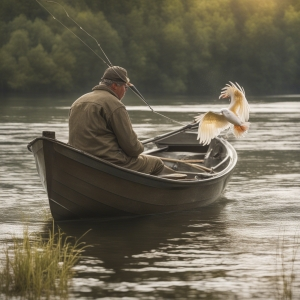Table of Contents:
Introduction to Fishing with Artificial Bait
Fishing is a fantastic activity, offering relaxation and joy unlike any other hobby. Whether you're new to fishing or an experienced angler, the choice between using natural or artificial bait is a fundamental consideration. This article will dive deep into the intriguing world of fishing with artificial bait.
Artificial baits, or lures, are man-made products designed to mimic the real deal - essentially fooling fish into biting. Using artificial baits comes with its own set of advantages and challenges, making it a highly engaging method of fishing. In this article, we'll uncover the pros and cons of using artificial bait, giving you the knowledge you need to maximize your fishing game. We'll also share some commonly used techniques to ensure your success while out on the water.
Let's dive in and learn why artificial bait has become a go-to option for many anglers around the globe.
Understanding Artificial Bait
Before we delve into the pros and cons of artificial bait, it's crucial to know exactly what we're dealing with. Artificial bait, also known as lures, are designed to mimic the prey of fish. They come in assorted colors, sizes, and styles to entice different species. Lures might imitate insects, worms, or small fish, catching the attention of potential catches.
Artificial baits are typically made from a variety of materials including plastic, metal and wood. They are crafted to move in a way that mimics the creatures they represent. This is accomplished by using specific designs and adding elements like feathers, rubber legs, or spinning blades.
The diverse range of artificial baits ensures that there’s something suitable for just about any fishing scenario. Whether it’s freshwater bass you’re after, or saltwater trevally, there’s a perfect lure out there for you.
Comparative Analysis of Using Artificial Bait for Fishing
| Topics | Pros | Cons | Techniques |
|---|---|---|---|
| Ease of Use | No need to handle live bait, last longer in tackle box | Some fish species prefer live bait | Jigging, trolling |
| Cost | Can be reused, less waste | Initial investment can be expensive | N/A |
| Availability | Widely available and in various styles | Some designs may not be available in all areas | N/A |
| Results | Can attract many different species of fish | May not be as effective for catching certain species of fish | Match the hatch, sight casting |
The Pros of Using Artificial Bait

There are several advantages to using artificial baits. First up, they're durable and lasting. Unlike live bait, artificial bait won't die or get soft and mushy during a long day on the water. This means you can reuse them multiple times, making them cost-effective in the long run.
Artificial baits also offer great versatility. They are available in a vast array of styles, shapes, sizes, and colors, letting you match the conditions and species you're targeting. They are equally effective in freshwater and saltwater environments.
Another bonus of using artificial bait is the thrill of the chase. This type of fishing often requires more skill and strategy, making a successful catch even more rewarding. You control the movement of the lure, requiring an understanding of your target species' feeding habits and natural prey.
Lastly, they're compact and easy to carry. You can pack an entire arsenal of lures in a small tackle box, letting you adapt quickly to changing conditions or target species.
The Cons of Using Artificial Bait
Like any fishing method, using artificial bait also has drawbacks. Firstly, artificial lures require a certain degree of skill to use effectively. The success of fishing with artificial bait often depends on the angler's ability to present the bait convincingly, which can take time and practice to master.
Secondly, artificial baits can be more expensive than their natural counterparts. While they are reusable, losing a costly lure to a snag can sting.
Moreover, some fish species may prefer live bait over artificial lures. Catfish and carp, for example, are often more attracted to the scent of natural bait. So, artificial baits might not always be the best choice for every fishing scenario.
Finally, with a large variety of lures available, choosing the right one can be overwhelming for beginners. The temptation to buy every new artificial bait can also put unexpected pressure on your wallet.
Choosing the Right Artificial Bait

Now that you know the pros and cons of using artificial bait, how do you go about picking the right one? The key here lies in understanding the fishing conditions and the type of fish you're targeting.
A crucial consideration is the color of your artificial bait. As a general rule, if you're fishing in murky or muddy waters, go with a bright, vibrant color to help fish spot your lure. On the other hand, in clear water, a more natural, subdued color could be more effective.
The size of your artificial bait is also significant. Larger lures usually attract bigger fish, while smaller lures will likely lure in smaller fish. Always try to match the size of your lure to the type of fish you're after or the natural prey in the area.
Movement is another factor to bear in mind. Some lures mimic the movement of injured prey, which can entice predatory fish to attack. Others may shimmer and reflect light to grab attention. The movement of your lure should align with what your target fish might find enticing.
Lastly, don't forget about the depth at which you're fishing. Some lures dive deep into the water when reeled in, while others float, making them ideal for shallow water fishing. Knowing the depth where your target fish resides helps in selecting the appropriate artificial bait.
Remember, choosing the right artificial bait is often a matter of trial and error, and while it can be challenging initially, with practice and patience, you'll become a pro at it!
Techniques for Fishing with Artificial Bait
Now that you're familiar with the pros and cons and how to choose artificial bait, let's delve into some techniques to enhance your fishing experience.
The casting and retrieving method is a basic yet effective technique. It involves casting your lure out into the water and then steadily retrieving it. The speed of your retrieve can greatly impact the effectiveness of this method. Slow retrieves often yield better results, as they allow fish more time to spot and attack the lure.
Jigging is another common artificial bait fishing technique. This approach involves lowering your lure into the water and then repeatedly lifting and dropping it. The erratic movement mimics an injured prey animal, which can be irresistible to predatory fish.
For those seeking a more active experience, fly fishing could be a fantastic option. Fly fishing involves using artificial flies as bait, and requires a special casting technique. This method is especially popular for catching trout and salmon.
Finally, trolling is a technique often used by boat anglers. In trolling, your lure is cast out and dragged behind a moving boat. This simulates the movements of swimming prey, attracting predatory fish species.
Conclusion

In summary, fishing with artificial bait offers fun challenges and great rewards for anglers of all skill levels. While it may require some practice and learning, the advantages of durability, reusability, and versatility make it an appealing technique. It's always important to consider the type of fish you're targeting and the environmental conditions. With so many types and techniques of using artificial baits, you're sure to find an approach that fits your style. Happy fishing!
Finesse Fishing with Artificial Bait
Anglers enthusiastic about heightened strategy might find joy in finesse fishing techniques with artificial bait. Finesse fishing is a method that involves lighter rods, thinner fishing lines, and skillful manipulation of lures to catch fish. This technique often leads to impressive results when dealing with wary fish or during challenging fishing conditions such as chilly winter months or overfished areas.
The crux of finesse fishing lies in the presentation of the artificial bait. It's all about making the lure behave like natural prey. This requires gentle lure handling, patient retrieves, and precise positioning to bait the fish into striking. Some popular finesse lures include drop shot rigs, wacky worms, and small jigs.
While finesse fishing can take a bit of practice to master, the rewards are plentiful. Not only does it often lead to more successful catches, but it also adds a layer of skill and strategy that makes fishing with artificial bait an exciting challenge.
Fishing with Artificial Bait: Case Studies
Let's take a look at some real-world examples of successful fishing with artificial bait to better understand its effectiveness.
Mike, an avid bass fisherman, switched from live bait to artificial lures several years ago. His preferred lure is a plastic worm, which he finds particularly useful when fishing in weed-choked waters. These places are bass magnets, but they also make it challenging to fish with natural bait. Mike can easily rig his plastic worm to be weedless, ensuring effective fishing, and simultaneously maintaining the bait's longevity.
Another case worth noting is Jane, a shoreline angler specializing in saltwater species. Jane's preferred artificial baits are plastic shrimps or crab lures. She enjoys the challenge of making the imitation bait move realistically in water, imitating the behavior of common prey species in her fishing area. The artificial baits allowJane to target specific saltwater species more efficiently, resulting in impressive catches of sea bass and red drum.
Lastly, there's Bill, who loves ice fishing for predator fishes like pike. Bill has experienced considerable success using flashy, noisy artificial baits. These lures work great in the clear waters typical of ice fishing scenarios. They attract fish through their egregious colors and vibrations in the water - something a live minnow would struggle to compete with.
As these cases demonstrate, there's a wide range of scenarios where artificial bait can lead to successful fishing. It's all about understanding the target species and generally matching the bait to the given fishing conditions.
Conclusion: Is Artificial Bait Worth It?
To wrap things up, artificial bait is undoubtedly a valuable tool in your fishing arsenal. Despite the potential challenges, the benefits it offers are too substantial to ignore. With bait durability, versatile application, and the strategic thrill, artificial bait adds an exciting dimension to your fishing experience.
Remember, successful artificial bait fishing requires time and patience. With practice and a little bit of trial and error, you will get the hang of it and work out which types of baits work best for your chosen fishing grounds. Perhaps the most important consideration when deciding on bait is the fish species you are targeting and the conditions in which you are fishing.
So is artificial bait worth it? Yes, definitely. Its advantages more than compensate for its disadvantages. Being open to learning and adapting will only elevate your fishing game. There's nothing quite like the feeling of outwitting a fish with a lure that you've skilfully manipulated - that's what makes fishing with artificial bait so addictive and fulfilling. Happy fishing!
Frequently Asked Questions About Fishing with Artificial Bait
What are the pros of fishing with artificial bait?
Fishing with artificial bait offers several advantages: it's cost-effective in the long run, available in a wide variety of shapes and colors, and is not reliant on local prey conditions.
What are the cons of fishing with artificial bait?
Despite their advantages, artificial baits have some drawbacks: they require more skill and patience compared to live bait, and certain fish species prefer live or natural baits.
What are the different types of artificial baits?
There are several types of artificial baits, including soft plastics, jigs, spinnerbaits, plugs, spoons, flies, and others. Each type is designed to imitate certain types of fish's natural prey.
When should I use artificial baits?
Artificial baits can be used at any time, but they're particularly useful when live bait is hard to obtain or not allowed. They're also good for casting long distances or in heavy cover.
How to fish with artificial bait?
Fishing with artificial bait requires practice and experimentation. You should match the size and color of the bait to the local prey, cast accurately, and use appropriate retrieve techniques to mimic natural prey movement.







